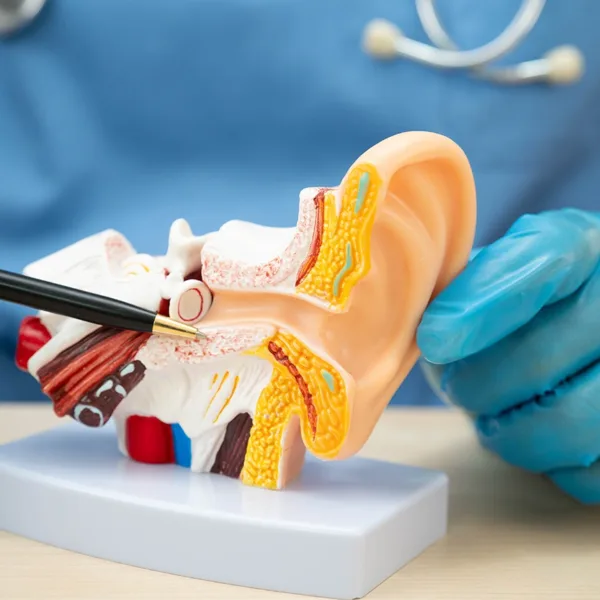
Occupational hearing loss is a common condition that affects 1 in 8 workers in the U.S. alone.1 Sadly, many people don’t realize their work environment could be putting them at risk of hearing damage until it’s too late. From loud sounds to chemical exposure, many workplace hazards can contribute to permanent hearing loss.
Understanding the risks and taking the right precautions are key to protecting your hearing. This guide provides a detailed overview of occupational hearing loss, covering symptoms, causes, preventative measures, and treatment options.
Jump ahead:
What Is Occupational Hearing Loss?
Occupational hearing loss is any type of permanent hearing damage caused by hazards in the workplace. Roughly 1 in 4 cases of hearing loss in the United States’ working population are caused by occupational factors.1
While some industries have a greater risk than others, occupational hearing loss is a possibility no matter where you work. Exposure to loud sounds, injuries, and certain chemicals can put you at risk of permanent hearing loss.
Symptoms
Since occupational hearing loss spans across various industries and risk factors, symptoms can present in many different ways. Symptoms may develop gradually over time due to repeated exposure or suddenly following a traumatic event.
Some common symptoms of occupational hearing loss include:
- Tinnitus (ringing in the ears)
- Dizziness or balance issues (vertigo)
- Sounds have a muffled or distorted quality
- It sounds like people are constantly mumbling
- Frequently asking people to repeat themselves
- Difficulty hearing in places with a lot of background noise
- Turning up the TV volume to uncomfortable levels for others
- Trouble hearing soft sounds like leaves rustling in the wind or footsteps
- Difficult hearing high-pitched sounds like birds chirping or children’s voices
If you are experiencing any of these symptoms or have noticed any other recent changes in your hearing, it’s important to have a hearing exam as soon as possible.
Occupational Hearing Loss Causes
Understanding the root causes of occupational hearing loss is essential for both employers and employees, so effective prevention strategies can be put in place and followed. From continuous exposure to loud noise levels, certain chemical agents, and more, the causes of occupational hearing loss are diverse.
We explore some of the most common causes below:
Occupational Noise-Induced Hearing Loss (ONIHL)
Occupational noise-induced hearing loss (ONIHL) is the most common cause of hearing loss at work, affecting 1.3 billion people worldwide.2 It’s caused when loud sounds damage the delicate hair cells in the inner ear responsible for sending auditory signals to the brain. These cells do not regenerate, so once the damage is done, permanent hearing loss is the result.
Studies 2 show that the following industries have the highest risk for occupational noise-induced hearing loss:
- Construction
- Manufacturing
- Mining
- Agriculture
- Utility
- Transportation
- Military
- Music and entertainment
The CDC emphasizes that while some fields have higher risks than others, all industries are at risk of ONIHL.1 Any sound at or above 70 decibels (dB) can cause hearing damage over time, while any sound that meets or exceeds 110 dB can cause hearing loss instantly.
Ototoxic Chemical Exposure
Some industries work with chemicals that have ototoxic effects, meaning they can damage hearing over time. According to the CDC, over 13 million employees work in industries that expose them to ototoxic chemicals every day.1
Some examples of ototoxic chemicals include:
- Toluene: primarily found in gasoline, paints, varnishes, adhesives, inks, cleaning agents, dyes, and nail polish.3
- Lead: common in batteries, plumbing pipes, fishing weights, paints, industrial manufacturing, ammunition, and even amusement park equipment.4
- Mercury: exposure can happen while mining, transporting, or manufacturing with mercury.5
- Arsenic: used in the manufacturing of glass, paper, textiles, pigments, adhesives, and wood preservatives. Also found in pesticides, hide tanning solutions, and some pharmaceuticals.6
- Xylene: commonly used in degreasing agents, paint thinners, adhesives, inks, and pesticides.7
- Styrene: used in the production of rubber, plastics, fiberglass insulation, piping, automotive components, food packaging, and carpet backing.8
- Organophosphate: a class of chemical compounds commonly used as an insecticide, which has been linked to permanent hearing loss in the agricultural industry.9
While many people don’t encounter these substances regularly, sometimes they are necessary for certain specialized jobs. In these instances, following OSHA guidelines and monitoring any changes in your hearing through regular hearing exams are essential to preserving your long-term auditory health.
Head and Ear Injuries
Physical injuries to the head, face, or ear can also lead to hearing loss at work. Damage resulting in a physical obstruction in the outer or middle ear is classified as conductive hearing loss (CHL) and may be reversible. In contrast, injuries causing damage to the delicate structures of the inner ear or the auditory nerve result in sensorineural hearing loss (SNHL), which is typically permanent.
Some examples of workplace injuries that may lead to hearing loss include:
- Blunt force trauma to the head, face, or ear: This can occur due to falls, being struck by falling objects, or any other kind of traumatic impact.
- Acoustic trauma from sudden and extremely loud noises: Exposure to impulsive sounds such as explosions (common in military, mining, and demolition work) or sudden equipment malfunctions can cause immediate and irreversible hearing damage.
- Ear barotrauma or pressure-related hearing damage: Rapid and significant changes in air or water pressure, such as those experienced in diving or aviation-related incidents, can damage the eardrum and middle ear, resulting in hearing loss.
It’s important to always follow all safety procedures and wear appropriate protective gear to minimize the risk of injury in the workplace. In the event of a head or ear injury, seeking prompt medical attention is essential and may prevent potential long-term issues like hearing loss.
Occupational Hearing Loss Prevention
While occupational hearing loss is a serious and often permanent condition, the good news is that it’s also largely preventable. When implemented effectively, hearing loss prevention strategies can protect workers from long-term auditory damage and improve overall workplace safety.
Below are some key tips for preventing occupational hearing loss:
Wear Proper Hearing Protection
One of the best things you can do to keep your ears safe at work is to wear proper hearing protection devices (HPDs). This includes earmuffs, earplugs, and other devices with the appropriate noise-reduction rating (NRR).
The Occupational Safety and Health Administration (OSHA) requires employers to implement a hearing conservation program if noise exposure exceeds 85 dB over an 8-hour time-weighted average (TWA). This includes providing HPDs, training, and consistent monitoring to make sure the work environment is as safe as possible.
Minimize Exposure to Ototoxic Chemicals
Hearing loss caused by exposure to ototoxic chemicals is permanent, so it’s incredibly vital to take effective, proactive steps to safeguard your auditory health. Below are some tips for minimizing chemical exposure at work, based on OSHA guidelines:10,11
- Elimination or substitution: If possible, eliminate the use of ototoxic chemicals or substitute with safer alternatives.
- Work practice controls: Rotate job assignments and adjust shifts so that employees are not more exposed to ototoxic chemicals.
- Wear personal protective equipment: This includes gloves, protective clothing, masks, eye protection, and more.
- Don’t bring substances home: Thoroughly wash your hands, shower, and change out of your work clothes to avoid bringing hazardous chemicals home to your family members and pets.
Regular Hearing Exams
No matter the industry you work in, routine hearing exams are key to monitoring your hearing health and catching any issues as soon as possible. This is especially critical if you work in a noisy environment or an environment with a high risk of ototoxic chemical exposure.
By attending regular appointments with a hearing care specialist, you can catch any signs of hearing damage early on and implement strategies to preserve your auditory health long-term.
Treatment Options
While most cases of occupational hearing loss are permanent, hearing aids are a life-changing treatment option for many people.
If you are experiencing any changes in your hearing, it is important to see a hearing specialist as soon as possible. Timely diagnosis is crucial to identify the underlying cause and determine the best treatment option for your needs.
Take the First Step Towards Better Hearing Health
Occupational hearing loss is a preventable condition, yet it remains one of the most common workplace injuries in the U.S.1 By understanding the causes, prioritizing proven prevention strategies, and attending routine hearing exams, you can take meaningful steps to protect your long-term hearing health.
At Audibel, our hearing specialists will work with you to create a treatment plan tailored to your unique occupation, lifestyle, and hearing needs. Don’t wait until the damage is already done—find an Audibel clinic near you today to take the first step towards protecting your hearing health for years to come.
References
- About occupational hearing loss. (2024, January 18). Noise and Hearing Loss. https://www.cdc.gov/niosh/noise/about/index.html
- Chen, K., Su, S., & Chen, K. (n.d.). An overview of occupational noise-induced hearing loss among workers: epidemiology, pathogenesis, and preventive measures. Environmental Health and Preventive Medicine, 25(1). https://doi.org/10.1186/s12199-020-00906-0
- Toluene – Overview | Occupational Safety and Health Administration. (n.d.). https://www.osha.gov/toluene
- Lead – Overview | Occupational Safety and Health Administration. (n.d.). https://www.osha.gov/lead
- Mercury – Overview | Occupational Safety and Health Administration. (n.d.). https://www.osha.gov/mercury
- World Health Organization: WHO. (2022, December 7). Arsenic. https://www.who.int/news-room/fact-sheets/detail/arsenic
- Xylenes | Medical Management Guidelines | Toxic Substance Portal | ATSDR. (n.d.). https://wwwn.cdc.gov/TSP/MMG/MMGDetails.aspx?mmgid=291&toxid=53
- Styrene | Toxic Substances | Toxic Substance Portal | ATSDR. (n.d.). https://wwwn.cdc.gov/tsp/substances/toxsubstance.aspx?toxid=74
- Mac Crawford, J., Hoppin, J. A., Alavanja, M. C. R., Blair, A., Sandler, D. P., & Kamel, F. (2008). Hearing loss among licensed pesticide applicators in the Agricultural Health study. Journal of Occupational and Environmental Medicine, 50(7), 817–826. https://doi.org/10.1097/jom.0b013e31816a8caf
- Chemical Hazards and Toxic Substances – Controlling exposure | Occupational Safety and Health Administration. (n.d.). https://www.osha.gov/chemical-hazards/controlling-exposure
- U.S. Department of Labor. (2014). OSHA 3680-06 2014 QUICK CARD. https://www.osha.gov/sites/default/files/publications/OSHA3680.pdf







Have a question or Comment?